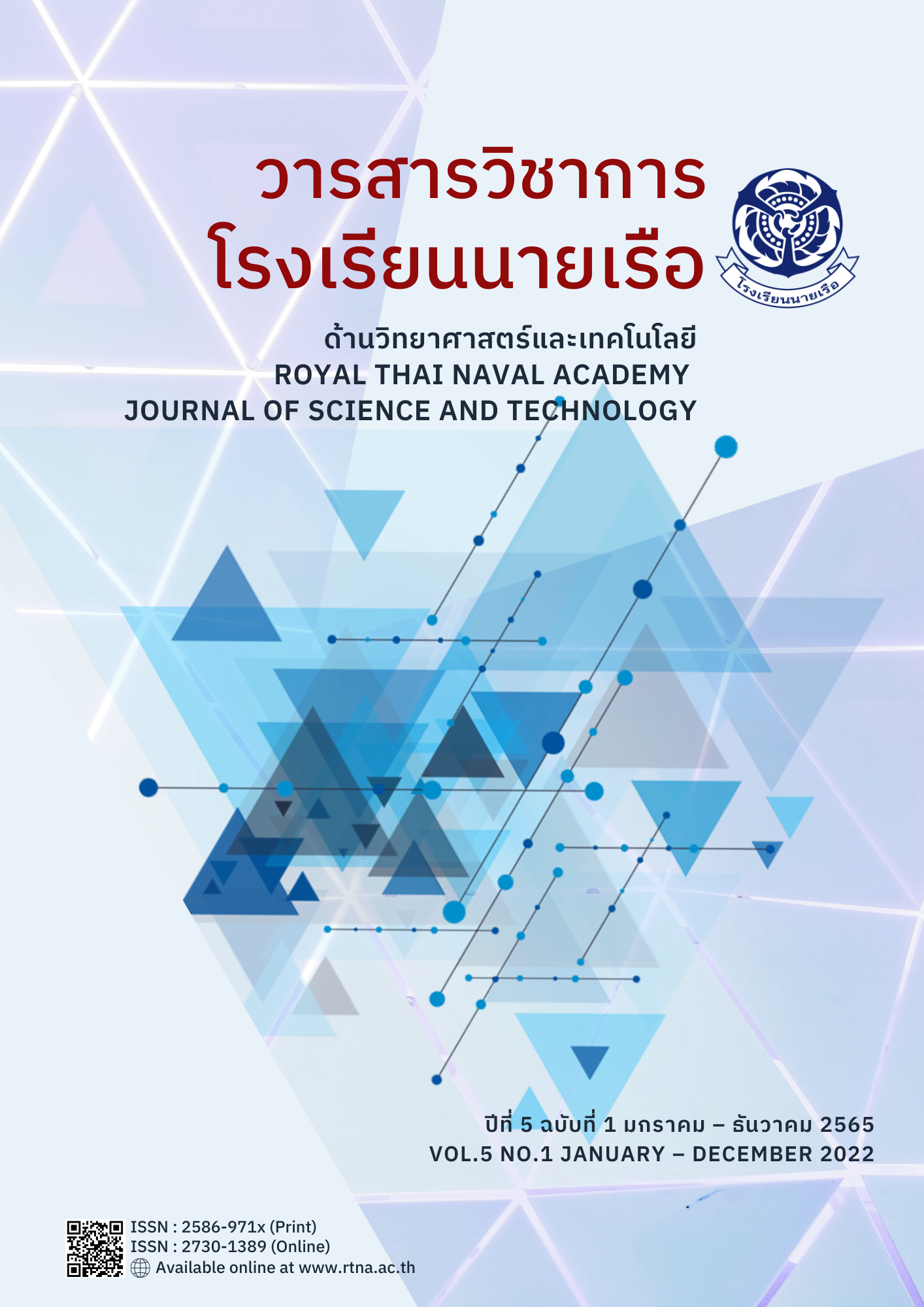Remote Sensing - Derived Oceanic Bathymetry in The Gulf of Thailand Using Landsat 8 Imageries
Main Article Content
Abstract
The objective of this research is to apply Landsat 8 satellite imagery for analyzing the depth in the Gulf of Thailand in three study areas boundaries based on nautical charts. The first study area is the inner Gulf of Thailand (Entrance to Mae Nam Chao Phraya), the second study area is Eastern Gulf of Thailand (Koh Saba to Koh Chik Nok), and the third study area is Western Gulf of Thailand (Ao Chumphon). The depth accuracy from the integration of nautical chart techniques, Satellite Derived Bathymetry (SDB) and Log-Band Ratio Method is higher than single-beam echo sounding. About the depth between 0-15 meters in the study areas, the results indicate the Coefficient of determination (R2) in the Inner Gulf of Thailand, Eastern Gulf of Thailand, and Western Gulf of Thailand as 0.8621, 0.9130 and 0.9304 respectively. Depth from the SDB charts precisely consistent with depth from nautical chart can be concluded that depth derived from the SDB is suitable especially the area in the western Gulf of Thailand. The result of the study confirms that the SDB method and Log-Band Ratio Method can be alternative methods to support hydrographic bathymetry surveys in areas where depth is less than 15 meters or where, hydrographic bathymetry data is unavailable.
Article Details

This work is licensed under a Creative Commons Attribution-NonCommercial-NoDerivatives 4.0 International License.
The author has the sole responsibility for the material published in RTNA Journal of Science and Technology, which the editorial board may not agree on that material.
RTNA Journal of Science and Technology owns the copyright of the text, the illustration, or other material published in the journal. No parts or the whole of the material published may be disseminated or used in any form without first obtaining written permission from the academy.
References
Lyzenga DR. Remote sensing of bottom reflectance and water attenuation parameters in shallow water using aircraft and Landsat data. Int J Remote Sens [Internet]. 1981 [cited 2022 Apr 1];2(1):71–82. Available from: http://dx.doi.org/10.1080/01431168108948342
Pe’eri S, Parrish C, Azuike C, Alexander L, Armstrong A. Satellite remote sensing as a reconnaissance tool for assessing nautical chart adequacy and completeness. Mar Geod [Internet]. 2014 [cited 2022 Apr 2];37(3):293–314. Available from: http://dx.doi.org/ 10.1080/01490419.2014.902880
Randazzo G, Barreca G, Cascio M, Crupi A, Fontana M, Gregorio F, et al. Analysis of very high spatial resolution images for automatic shoreline extraction and satellite-derived bathymetry mapping. Geosciences (Basel) [Internet]. 2020 [cited 2022 Apr 6];10(5):172. Available from: http://dx.doi.org/10.3390/geosciences10050172
Duplančić Leder T, Leder N, Peroš J. Satellite Derived Bathymetry survey method - example of Hramina Bay. Trans marit sci [Internet]. 2019 [cited 2022 Apr 12];8(1):99–108. Available from: http://dx.doi.org/10.7225/toms.v08.n01.010
Stumpf RP, Holderied K, Sinclair M. Determination of water depth with high-resolution satellite imagery over variable bottom types. Limnol Oceanogr [Internet]. 2003 [cited 2022 Apr 15];48(1part2):547–56. Available from: http://dx.doi.org/10.4319/lo.2003.48.1_part_2.0547
IHO S-44. IHO Standard for Hydrographic Surveys. 6th ed. [place unknown]: International Hydrographic Organization; 2020.
กรมทรัพยากรทางทะเลและชายฝั่ง, สถาบันวิจัยและพัฒนาทรัพยากรทางทะเลและชายฝั่ง. รายงานคุณภาพน้ำทะเล ปี 2562 - 2563. สมุทรสาคร: บอร์น ทู บี พับลิชชิ่ง; 2564.
Stumpf RP, Holderied K, Sinclair M. Determination of water depth with high-resolution satellite imagery over variable bottom types. Limnol Oceanogr [Internet]. 2003 [cited 2022 Apr 19];48(1part2):547–56. Available from: http://dx.doi.org/10.4319/lo.2003.48.1 _part_2.0547
Pennucci G, Grasso R, Trees C. A study for near-shore characterization using high-resolution hyperspectral and multispectral images. In: IGARSS 2008 - 2008 IEEE International Geoscience and Remote Sensing Symposium. IEEE; 2008.
Jagalingam P, Akshaya BJ, Hegde AV. Bathymetry mapping using Landsat 8 satellite imagery. Procedia Eng [Internet]. 2015 [cited 2022 Apr 21];116:560–6. Available from: http://dx.doi.org/10.1016/j.proeng.2015.08.326
Kimeli A, Thoya P, Ngisiang’e N, Ong’anda H, Magori C. Satellite-derived bathymetry: A case study of Mombasa Port Channel and its approaches, Kenya. West Indian Ocean J Mar Sci [Internet]. 2018 [cited 2022 Apr 22];17(2):93. Available from: http://dx.doi.org/10.4314 /wiojms.v17i2.8
Tang KKW, Mahmud MR. Imagery-derived bathymetry in Strait of Johor’s turbid waters using multispectral images. ISPRS - Int Arch Photogramm Remote Sens Spat Inf Sci [Internet]. 2018 [cited 2022 Apr 23];XLII-4/W9:139–45. Available from: http://dx.doi.org/10.5194/isprs-archives-xlii-4-w9-139-2018
Saeed R, Abdelrahman SM, Negm A. Satellite-Derived Bathymetry using Landsat-8 imagery for Safaga coastal zone, Egypt. Acta Marisiensis Seria Technologica [Internet]. 2021 [cited 2022 Apr 25];18(1):8–15. Available from: http://dx.doi.org/10.2478/amset-2021-0002
Gistda.or.th. [cited 2022 Apr 25]. Available from: https://www.gistda.or.th/main/th/ node/93.
Xu H. Modification of normalised difference water index (NDWI) to enhance open water features in remotely sensed imagery. Int J Remote Sens [Internet]. 2006 [cited 2022 Apr 29];27(14):3025–33. Available from: http://dx.doi.org/10.1080/01431160600589179
Meliala L, Wibowo WA, Amalia J. Satellite derived bathymetry on shallow reef platform: A preliminary result from Semak Daun, seribu islands, Java Sea, Indonesia. KnE eng [Internet]. 2019 [cited 2022 Apr 30]; Available from: http://dx.doi.org/10.18502/keg.v4i3. 5849


